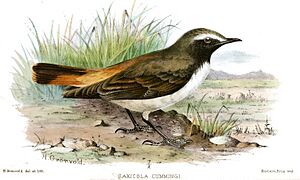Kurdish wheatear facts for kids
Quick facts for kids Kurdish wheatear |
|
|---|---|
 |
|
| Conservation status | |
| Scientific classification |
The Kurdish wheatear (Oenanthe xanthoprymna) is a small bird from the Muscicapidae family. People also call it the Kurdistan wheatear, chestnut-rumped wheatear, or red-rumped wheatear. It's known for its bright rump feathers.
The red-tailed wheatear was once thought to be a type of Kurdish wheatear. Now, scientists usually see them as different species. Sometimes, these two birds might mix in Iran.
Contents
About the Kurdish Wheatear
The Kurdish wheatear is about 14 centimeters (5.5 inches) long. Male birds have a pale grey head and neck. A white stripe goes above their eyes, separating the grey from their black face and throat. Their back is brownish-grey, and their belly is white or light brown.
Their wings are dark grey, and the flight feathers have brown edges. The sides of their body and the feathers under their tail are orange. Their tail is white at the base with a dark band at the end.
Female Kurdish wheatears look similar to males. However, their colors are softer. They have a grey patch around their eyes instead of a dark face and throat. The bright orange rump and tail feathers are easy to spot, especially when the male is flying in winter.
Kurdish Wheatear Calls
The Kurdish wheatear makes a harsh sound, like chack-chack-chack. Its song is a bit squeaky and warbling. It sounds similar to the song of the northern wheatear.
What Kurdish Wheatears Eat
The Kurdish wheatear mainly eats small insects. Its favorite food is ants.
Reproduction and Life Cycle
Kurdish wheatears build their nests among rocks. They might choose a crack in a rock, a pile of loose stones, or under a large boulder. The nest is shaped like a bowl. It is carefully lined with soft materials like wool, animal hair, and dry grasses.
Female wheatears usually lay four or five eggs. The eggs are bluish-white. They have a few small, chestnut-brown speckles on them.
Where Kurdish Wheatears Live
The Kurdish wheatear breeds in the Middle East. This includes south-east Turkey, northern Iraq, and western Iran. They also breed in parts of the former USSR.
In winter, these birds fly south. They go to southern Iran, the Arabian Peninsula, Egypt, Sudan, Eritrea, and north-east Somalia. Sometimes, they even reach north-west India.
It's not fully clear if all Kurdish wheatears migrate. Some might just move to lower, warmer areas for the winter. They prefer to live in open hillsides, heathland, and dry, scrubby desert areas.
The Kurdish wheatear is listed as "least concern" by the IUCN Red List of Threatened Species. This means it is not currently at risk of disappearing. This is because it lives across a very large area.


